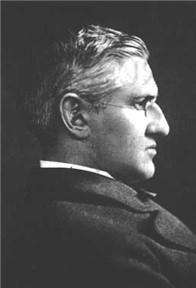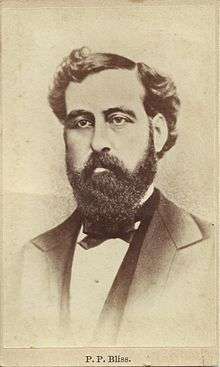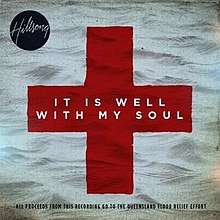It Is Well with My Soul
| It Is Well With My Soul | |
|---|---|
| by Horatio Spafford | |
 Horatio Spafford | |
| Genre | Hymn |
| Written | 1873 |
| Based on | 3 John 2 |
| Meter | 11.8.11.9 with refrain |
| Melody | "Ville du Havre" by Philip Bliss |
"It Is Well With My Soul" is a hymn penned by hymnist Horatio Spafford and composed by Philip Bliss. First published in Gospel Songs No. 2 by Ira Sankey and Bliss (1876), it is possibly the most influential and enduring in the Bliss repertoire and is often taken as a choral model, appearing in hymnals of a wide variety of Christian fellowships.[1]
Background
This hymn was written after traumatic events in Spafford's life. The first was the death of his son at the age of two and the Great Chicago Fire of 1871, which ruined him financially (he had been a successful lawyer and had invested significantly in property in the area of Chicago that was extensively damaged by the great fire). His business interests were further hit by the economic downturn of 1873, at which time he had planned to travel to Europe with his family on the SS Ville du Havre. In a late change of plan, he sent the family ahead while he was delayed on business concerning zoning problems following the Great Chicago Fire. While crossing the Atlantic Ocean, the ship sank rapidly after a collision with a sea vessel, the Loch Earn, and all four of Spafford's daughters died. His wife Anna survived and sent him the now famous telegram, "Saved alone …". Shortly afterwards, as Spafford traveled to meet his grieving wife, he was inspired to write these words as his ship passed near where his daughters had died.[2] Bliss called his tune Ville du Havre, from the name of the stricken vessel.[3]


The Spaffords later had three more children. On February 11, 1880, their son, Horatio Goertner Spafford, died at the age of four, of scarlet fever. Their daughters were Bertha Hedges Spafford (born March 24, 1878) and Grace Spafford (born January 18, 1881). Their Presbyterian church regarded their tragedy as divine punishment. In response, the Spaffords formed their own Messianic sect, dubbed "the Overcomers" by American press. In 1881, the Spaffords, including baby Bertha and newborn Grace, set sail for Ottoman-Turkish Palestine. The Spaffords settled in Jerusalem and helped found a group called the American Colony. Colony members, later joined by Swedish Christians, engaged in philanthropic work among the people of Jerusalem regardless of their religious affiliation and without proselytizing motives—thereby gaining the trust of the local Muslim, Jewish, and Christian communities. During and immediately after World War I, the American Colony played a critical role in supporting these communities through the great suffering and deprivations by running soup kitchens, hospitals, orphanages and other charitable ventures. The colony later became the subject of Jerusalem by the Nobel prize-winning author, Swedish novelist Selma Lagerlöf.[2]
Original lyrics
When peace like a river, attendeth my way,
When sorrows like sea billows roll;
Whatever my lot, Thou hast taught me to knowa
It is well, it is well, with my soul.
Refrain
It is well, (it is well),
With my soul, (with my soul)
It is well, it is well, with my soul.
Though Satan should buffet, though trials should come,
Let this blest assurance control,
That Christ has regarded my helpless estate,
And hath shed His own blood for my soul.
My sin, oh, the bliss of this glorious thought!
My sin, not in part but the whole,
Is nailed to the cross, and I bear it no more,
Praise the Lord, praise the Lord, O my soul!
For me, be it Christ, be it Christ hence to live:
If Jordan above me shall roll,
No pang shall be mine, for in death as in life,
Thou wilt whisper Thy peace to my soul.
But Lord, 'tis for Thee, for Thy coming we wait,
The sky, not the grave, is our goal;
Oh, trump of the angel! Oh, voice of the Lord!
Blessed hope, blessed rest of my soul.
And Lord, haste the day when the faith shall be sight,
The clouds be rolled back as a scroll;
The trump shall resound, and the Lord shall descend,
A song in the night, oh my soul!b
- a "know" (at the end of the third line) was changed to "say".
- b "A song in the night, oh my soul" (last line) was changed to "Even so, it is well with my soul".
Hillsong Church version
| "It Is Well With My Soul" | ||||
|---|---|---|---|---|
 | ||||
| Single by Hillsong Church | ||||
| Released | 2011 | |||
| Recorded | 2011 | |||
| Genre | Contemporary worship | |||
| Label | Hillsong Music Australia | |||
| Hillsong Music Australia Singles singles chronology | ||||
| ||||
Hillsong Live team recorded a special single in December 2010 to aid victims of the 2010–2011 flooding in Queensland, Australia. It reached the ARIA Singles Chart Top 100[5] with all proceeds from the sale of this single going to the relief effort. The song features Darlene Zschech as lead vocalist, with a new added bridge composed by Reuben Morgan and Ben Fielding, and was recorded in Sydney, Australia in three days, mixed in England overnight and mastered in Los Angeles, before being released in the iTunes Store the following weekend.
References
- ↑ The presence of a refrain makes the item technically a gospel song versus a hymn in the strict sense.
- 1 2 "The American Colony in Jerusalem, 1870-2006". Retrieved May 2, 2013.
- ↑ McCann, Forrest M. (1997). Hymns and History: An Annotated Survey of Sources. Abilene, Texas: ACU Press. ISBN 0-89112-058-0, pp. 154, 327-328, 359-360, 520, 597.
- ↑ "History". Kosinski Studio. Archived from the original on March 11, 2013. Retrieved March 26, 2013.
- ↑ "The ARIA Report" (PDF). Australian Recording Industry Association (ARIA). 31 January 2001. Archived from the original (PDF) on 21 February 2011. Retrieved 22 June 2014.
External links
| Wikisource has original text related to this article: |
- Library of Congress item mamcol.016 High resolution images of the restored original manuscript (up to 22 MB) front AND back at the Library of Congress. (Includes an extra verse on the back, as well as notes from his prayer meetings)
- SpaffordHymn.com The original Hymn manuscript
- The American Colony in Jerusalem (A Library of Congress Exhibition)
- McCann, Forrest Mason (1997). Hymns & History: An Annotated Survey of Sources. Abilene, Texas: ACU Press, pp. 327–328, 520, 597. ISBN 0-89112-058-0